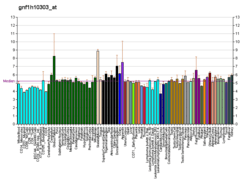VN1R2
Vomeronasal type-1 receptor 2 is a protein that in humans is encoded by the VN1R2 gene.[4][5]
| VN1R2 | |||||||||||||||||||||||||
|---|---|---|---|---|---|---|---|---|---|---|---|---|---|---|---|---|---|---|---|---|---|---|---|---|---|
| Identifiers | |||||||||||||||||||||||||
| Aliases | VN1R2, V1RL2, vomeronasal 1 receptor 2 | ||||||||||||||||||||||||
| External IDs | MGI: 3645524 HomoloGene: 85978 GeneCards: VN1R2 | ||||||||||||||||||||||||
| |||||||||||||||||||||||||
| |||||||||||||||||||||||||
| |||||||||||||||||||||||||
| Orthologs | |||||||||||||||||||||||||
| Species | Human | Mouse | |||||||||||||||||||||||
| Entrez | |||||||||||||||||||||||||
| Ensembl |
| ||||||||||||||||||||||||
| UniProt | |||||||||||||||||||||||||
| RefSeq (mRNA) | |||||||||||||||||||||||||
| RefSeq (protein) | |||||||||||||||||||||||||
| Location (UCSC) | Chr 19: 53.26 – 53.26 Mb | n/a | |||||||||||||||||||||||
| PubMed search | [2] | [3] | |||||||||||||||||||||||
| Wikidata | |||||||||||||||||||||||||
| |||||||||||||||||||||||||
References
- GRCh38: Ensembl release 89: ENSG00000196131 - Ensembl, May 2017
- "Human PubMed Reference:". National Center for Biotechnology Information, U.S. National Library of Medicine.
- "Mouse PubMed Reference:". National Center for Biotechnology Information, U.S. National Library of Medicine.
- Rodriguez I, Mombaerts P (Jul 2002). "Novel human vomeronasal receptor-like genes reveal species-specific families". Curr Biol. 12 (12): R409–11. doi:10.1016/S0960-9822(02)00909-0. PMID 12123587.
- "Entrez Gene: VN1R2 vomeronasal 1 receptor 2".
Further reading
- Takeda S, Kadowaki S, Haga T, et al. (2002). "Identification of G protein-coupled receptor genes from the human genome sequence". FEBS Lett. 520 (1–3): 97–101. doi:10.1016/S0014-5793(02)02775-8. PMID 12044878.
- Strausberg RL, Feingold EA, Grouse LH, et al. (2003). "Generation and initial analysis of more than 15,000 full-length human and mouse cDNA sequences". Proc. Natl. Acad. Sci. U.S.A. 99 (26): 16899–903. doi:10.1073/pnas.242603899. PMC 139241. PMID 12477932.
- Zhang J, Webb DM (2003). "Evolutionary deterioration of the vomeronasal pheromone transduction pathway in catarrhine primates". Proc. Natl. Acad. Sci. U.S.A. 100 (14): 8337–41. doi:10.1073/pnas.1331721100. PMC 166230. PMID 12826614.
This article incorporates text from the United States National Library of Medicine, which is in the public domain.
This article is issued from Wikipedia. The text is licensed under Creative Commons - Attribution - Sharealike. Additional terms may apply for the media files.


